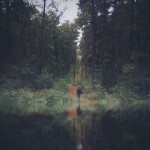
Searching for Carcosa by Joel A
Fifteen years ago, a mid-western young man fell in love with a red-headed Louisiana bayou girl and without a thought left the snow and flat plains behind for the wetlands and pine trees of Louisiana. Culture shock was a given.
Long before “YOLO”, Louisianans have been marching to the beat of their own drummer, declaring “laissez bon temps rouler”. Most of the world may hear Louisiana and relive drunken memories of stumbling around Bourbon Street, but New Orleans is but a small part of what makes Louisiana unique.
Recently, a large number of people’s attentions, including my own, have been captured by HBO’s “True Detective” and though the lead actors, Matthew McConaughey and Woody Harrelson, sizzle, I believe the Louisiana scenery steals the show.
Though filming in and around New Orleans, the director captured the gritty realism far removed from the French Quarter and it’s what contributes to the believability of the story line. Deep in the marshes of the Louisiana bayou, hidden behind the natural gas plants and oil refineries, you can believe that Carcosa exists.

“He said there’s this place down south, er, all these rich men go to, er, devil worship… He said, er… they sacrifice kids and whatnot, women and children all got, all got, murdered there… and, um, something about some place called Carcosa, and the Yellow King. He said there’s all these like old stones out in the woods, people go to, like, worship… He said, er, he said there’s just so much good killing down there…” –Charlie Lang – “True Detective”

Even I, someone surrounded by the state every day, was drawn into the locations mentioned in the series, I couldn’t wait to grab my Nokia Lumina 1020 and see if I can capture the abandoned, forgotten quality of some of these scenes that make you wonder what could have happened there and why everyone left.

I drove the real locations mentioned in the series, even though the director may have filmed far away, the Creole Nature Trail area which has been ravaged by two major hurricanes in the last ten years. Areas where FEMA trailers still dot the landscape, alligators outnumber people and sometimes three meals a week served on their dinner tables will consist of seafood caught themselves.
I drove Hwy 31, down by Bayou Teche, through Breaux Bridge, past St Martinville, close to Spanish Lake where the show mentioned the Bunny Ranch existed. I walked around Lake Martin, past signs warning me not to feed the alligators.

As I drove through some small towns, past derelict buildings, I remember Matthew McConaughey’s character, Rust’s quote from the show, “This place is like someone’s memory of a town, and the memory is fading.” The Louisiana marsh is disappearing almost as quickly as its population.
Yet the population that remains is determined. Though the show that inspired this photo trip is steeped in violence, murders and drugs, and I know that these things exist here in Louisiana, as well as everywhere, the people that I encountered were the most welcoming I’ve ever had the pleasure to meet. From the young boys crabbing on the dock, wanting me to see the big fish they caught, to the Cajun musicians I stopped to listen to at the Savoy Music Center in Eunice or the owner of the meat market that helped me pick out some of the best stuffed sausage I ever tasted, their Louisiana charm was contagious. No Yellow King or stick figures in sight, at least not this trip.

About Author
Latest stories
 Joel AversingOctober 17, 2014Second Week of October
Joel AversingOctober 17, 2014Second Week of October Joel AversingJune 2, 2014The Fleeting Summer
Joel AversingJune 2, 2014The Fleeting Summer- FEATUREMarch 17, 2014Searching for Carcosa
- StoriesFebruary 10, 2014No Grand Romantic Gestures Required

Such a great little story. Sounds likens great adventure. Thanks for sharing this.
Jeff
Great work, Joel. You really make me miss home in this one.
One of my dream trips is to drive around Louisiana and your article just confirms that it is something I really need to do! Thanks for the story and beautiful pictures — it really looks like a very special and unique place.